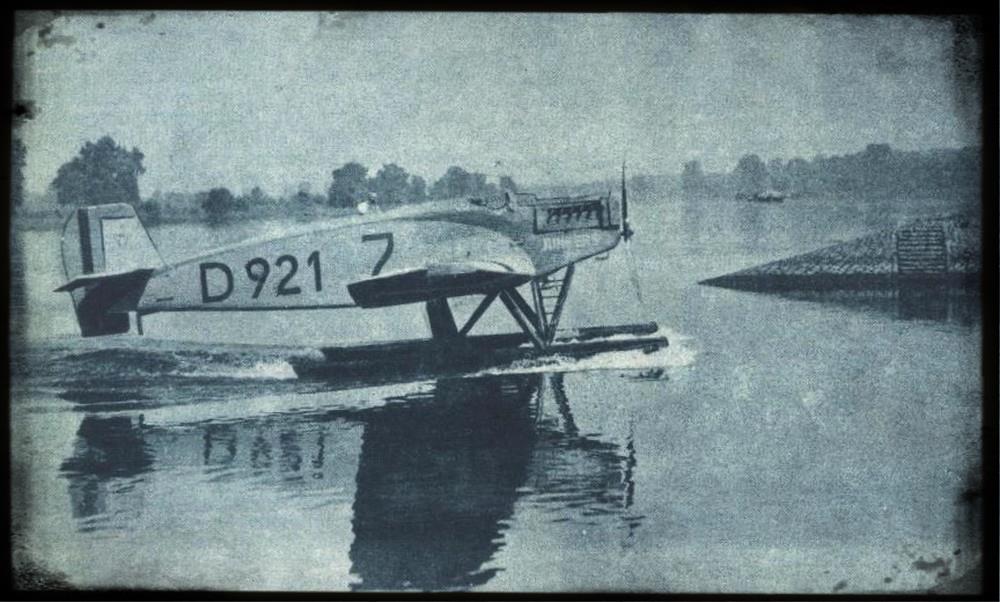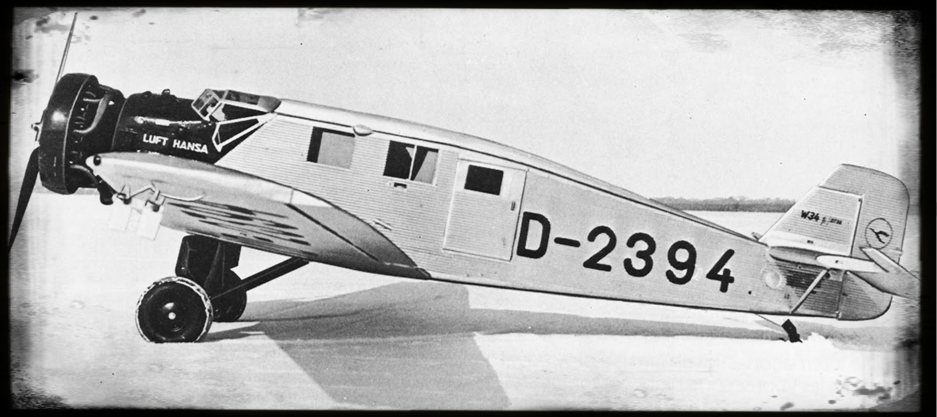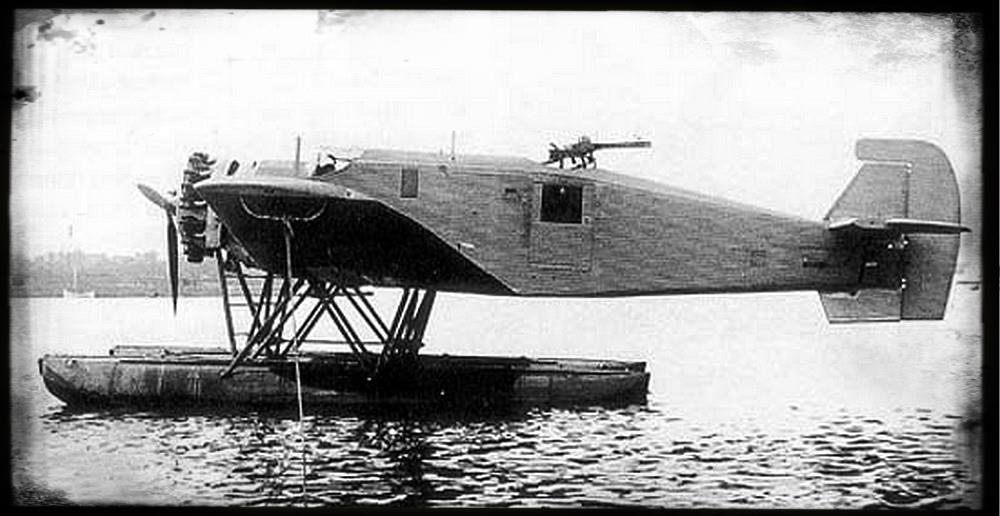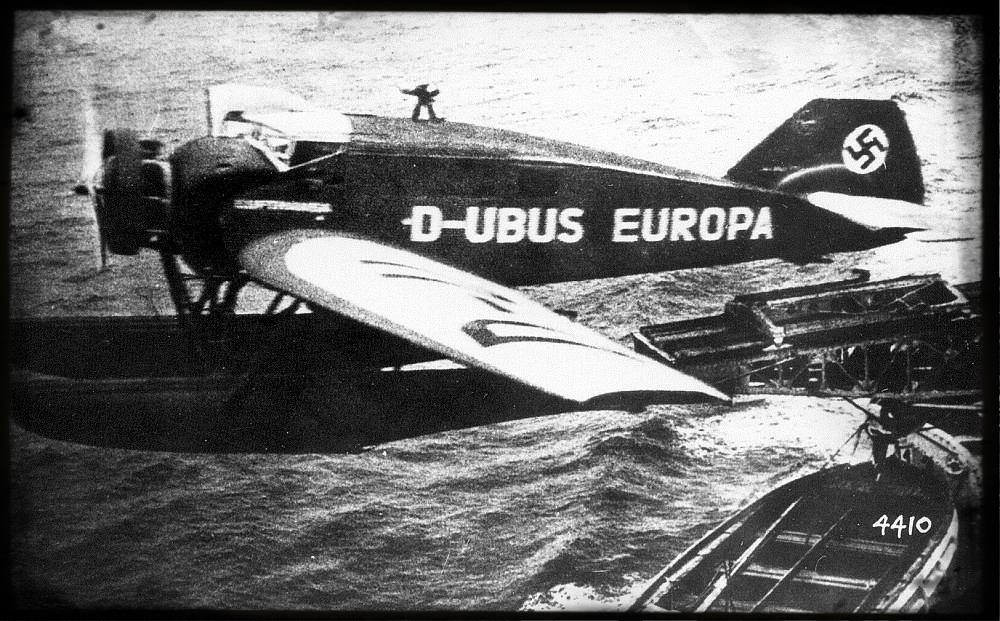Junkers W33 / W34
see also: Junkers W33 Production List / Junkers W33 Survivor List / Junkers W33 Philatelic Items / Junkers W33 Model Kits
cantilever monoplane Cargo and Passenger Airliner, F/F 17 Jun 1926, 199 x W33, 100 x W34, 5 x Ju46
developed by Junkers Flugzeugwerke in Dessau by Pohlmann

Junkers W33 Prototype of 1926
Historical Background:
The Junkers W33 was a direct modification of the Junkers F13 for cargo operations. The fuselage was lower than that of the F13 as there was no passenger compartement and the initial series did not have any windows in the cargo compartement. For combined cargo/passenger operations these windows were again introduced on later versions of the W33. The cargo loading could be performed through a side door or through a door in the cabin roof. On June 17th 1926 Zimmermann performed the first flight of the Junkers W33 (c/n 794). The prototype was a seaplane version and the first flight was performed on river Elbe at Leopoldshafen near Dessau. 
Junkers W34 of 1933
The first W34 was first flown just a few weeks after the W33 on July 7th 1926 by Zimmermann. Both prototypes appeared nearly identical except of the different engines. Instead of the Junkers L5 engine of the W33, the W34 was equipped with a 353kW Gnome et Rhone Jupiter VI engine. While future developements of the W33 kept the Junkers engines, the W34 was offered with a bride area of different engines, which also influenced the outside appearance and dimensions of the W34. Also the cabin roof was a little bit higher as on the W33, making the W34 more capable as a combined cargo and passenger airliner. Finally the early serial production W34 also show differences at the tail unit, which was larger than that of the W33. 
Junkers / AFI K43 Prototype of 1930
While the W33/W34 could be built in Germany after the ban over Germany's aviation industry was lowered in 1926, Junkers still was forced to convert his aircraft for military purposes outside of Germany. A military derivate was built from the W34 at A.B. Flygindustri at Limhamn in Sweden under the designator K43. This K43 received a machine gun tower at the rear part of the cabin. It could be used as a transport aircraft, but also as a light bomber aircraft. At least 18 militarized K43 left Limhamn for Finland, Argentina, Portugal, Bolivia and Chile. Additional 21 W33/W34 should have been built at Limhamn. Some of these were ambulance aircraft and transport aircraft for military purposes. One W33g was sold to the Swedish Air Force in 1933 and designated as Trp 2. It was used until 1935 as an ambulance aircraft in Sweden. Two further W34h were used by the Swedish Air Force as Trp 2A between 1933 and 1945 for the same purpose.
A large number of W33 aircraft was ordered from Russia. The parts for these aircraft were built at Dessau and were shipped Irkutsk and to the Dobrolet repair station at Moscow, where the aircraft were finally assembled since 1928. These W33 were used in Russia as PS-3. They were used until 1941 for postal and cargo flights mainly in Siberia. In March 1933 the Dobroljot repair station at Irkutsk started the construction of an own W33 without the support of Junkers. Until 1935 a total of at least nine of those socalled PS-4 were built at Irkutsk and Moscow. These PS-4 showed several differences to the original W33. Like the initial W33 of 1926 the PS-4 had no windows in the cargo compartement as it was used only as a freighter aircraft in Siberia.
W33/W34s were used for a wide area of utilization purposes, i.e. as transport, reconnaissance or bomber aircraft, but also as ambulance and pest control aircraft. They were used by operators on all five continents. The Dessau W33 production was stopped during 1932. At Limhamn some K43s were still built in 1933, when production was stopped there. The last W33s were built in Russia during late 1934 / early 1935. In 1933 Luftwaffe again ordered a larger number of W34s, which were delivered until 1935. These aircraft were later used during the Spanish Civil War by Legion Condor. After the end of WWII most W33/W34 were retired. The last W34 was a Canadian W34, which went out of service in 1961. 
Junkers Ju46fi
In 1932 the W34 design was reviewed for a special utilization by Luft Hansa for postal flights launched from the NDL steamliners "Europa" and "Bremen". These postal flights were already performed since summer 1929 with Heinkel He 12 and Heinkel He 58 aircraft. Special catapults were installed on board the two transatlantic ocean liners, from which the aircraft was launched with postal cargo about 1000km in front of the coast. These advanced postal flights reduced the travelling time of the postal cargo by about one day. In 1932 Luft Hansa was looking for more modern aircraft designs for these missions. Due to the good experience from the W34, they asked Junkers to make this aircraft usable for catapult take offs. Zindel and Pohlmann started the design under the designator Ju 46. Compared to the original W34, the Ju 46 got a more strengthened structure for the catapult forces and a larger tail unit. The Ju46 was first flown in March 1932 and in April 1932 the D-2244 was assigned to the steamliner "Europa". These Ju46s were painted in a red livery, so that they could be discovered in case of an emergency landing on sea. Due to the improved range of the Ju46, catapult take offs now could be performed about 1500 km in front of the coast. They flew to New York on westbound routes, while on eastbound routes they landed at Southampton for a refuelling stop and then continued to Bremen. The Ju46s used on these transatlantic routes were typically used for one summer season. Due to massive corrosion problems they were then replaced by new aircraft. A total of five Ju46s were built until 1933
Record flights of the W33:
1927 World Record Flights of the W33
On March, 16th 1927 a continous flight world record was achieved by Schnabele
with a W33L. With 500kg payload he flew 15hrs and 57 minutes.
Three days later Junkers pilot Loose achieved the same record with a W33 seaplane.
He flew 14hrs and 8 minutes with 500kg payload over 1702km, which means
also the world record for distance.
On March 21th, 1927 Loose and Schnabele together achieved a further record
with the landplane W33L with 22hrs and 11 minutes with 500 kg payload.
During this flight they achieved also a distance record with 2735km.
On July 5th, 1927 Junkers pilots Zimmermann and Risztics achieved
another world record for continous flight with a W33L with 65hrs and 25 minutes
Risztics and Edzard achieved the next W33 world record on August, 3rd 1927
with a W33. They flew for a distance of 4660 km a new distance world record.
They needed 52hrs and 22 minutes for that flight
12.04.1928 First East-West Atlantic Crossing
The W33 was the first aircraft to cross the Atlantic Ocean from East to West.
On April 12th, 1928 Hermann Koehl, Guenther von Huenefeld and Major Fitzmaurice
started with D-1197 Bremen (c/n 2504) from the Irish Baldonell to New York.
After 36 hours they landed at Greenly Island on Labrador.
The original "Bremen" today is owned by the Henry Ford Museum in Detroit.
and is currently under display at Bremen Airport in Germany.
The 1928 transatlantic crossing was already Koehl's second approach.
On August, 14th 1927 Koehl, Loose and Huenefeld
already took off from Germany with "Bremen", together with Risztics,
Edzard and Knickerbocker onboard the W33 "Europa" for the first approach. But this approach
failed due to bad weather and engine troubles of "Europa".
Sept. 1928 East Asia Flight of Hunefeld
During September 1928 Hunefeld and Lindner used another W33 (c/n 2506),
which was also named "Europa", for a flight to East Asia. They needed 12 days
and 90 flying hours for the 14250 km route to Tokio with 10 refuelling stops.
July 1929 First Rocket supported Take off with a W33
In July 1929 Zimmermann performed the first take off with the support of rockets
mounted on a W33. Four Eisfeld rockets were used during a few seconds of the
take off run on the river Elbe near Dessau.
02.11.1930 First Inflight Fueling with a W33
Luft Hansa and DVL tested inflight fueling of aircraft in 1930.
A DVL Fokker F II was the tanker aircraft, while the W33 was fuelled
through a 20 meter long connection.
Record flights of the W34:
11.05.1927 Speed Record Flight
On May, 11th 1927 Georg Jueterbock reached a new world speed record with a W34.
With 500kg payload he reached a speed of 194,2 km/h over 500km.
The flight was continued over 1000km with 181,44 km/h.
14.09.1928 Altitude Record
On September, 14th 1929 again Jueterbock reached a new altitude record with a W34.
With 500kg payload he reached 9190 meters. Later on with 1000 kg he reached 7907 meters.
In the same year Franz Kneer reached an altitude of 6389 meters with 1000kg payload
which was the new altitude record for seaplanes.
26.05.1929 World Altitude Record
On May, 26th 1929 Willy Neuenhofen reached a new world altitude record with a W34.
In 45 minutes Neuenhofen climbed up to 12739 meters. The W34be (c/n 2600) was equipped with
a new larger wing and a Bristol Jupiter VII engine and a minimum of equipment on board.
25.07.1929 Rocket Take off with W34
On July, 25th 1929 first trials with take off supporting rockets were made with a W34.
The aircraft was flown by Wilhelm Zimmermann, who started the take off run with
the conventional engine power. Then several ignitions of the Eisfeld-Pulver-rockets
were made, which lifted the aircraft up into the air. The trials were performed with
a W34 seaplane with floaters at Leopoldshafen on the river Elbe near Dessau.
It was the first time to use rocket power for the take off support.
| Aircraft | year | engine | length in m | span in m | wing area im sqm | net weight in kg | payload in kg | seats | speed in km/h | range in km |
|---|---|---|---|---|---|---|---|---|---|---|
| W33 b,b1, c, d L | 1926 | Junkers L5 (230kW) | 10,50 | 18,35 | 43,00 | 1200 | 900 | 2 seats | 195 | 1000 |
| PS-4 | 1931 | Junkers L5 | n.a. | 18,35 | 44,00 | 1410 | 690 | 2 seats | 188 | n.a. |
| W34a, b | 1926 | 1 x G&R Jupiter VI (353kW) | 10,50 | 18,35 | n.a. |
| 925 | 2 seats | 210 | n.a. |
| K43 | 1927 | BMW Hornet (386kW) | 10,25 | 17,75 | 44,00 | 1710 | 770 *) | 1 pilot + 2 obs. | 215 | 800 *) |
| Ju46fi | 1932 | BMW Hornet C (441kW) | 11,10 | 18,00 | 44,00 | 1730 | 1470 | 2 seats | 230 | 2000 |
**) two aircrafts were equipped with Hornet T2D1
Junkers W33/W34 Designators:
- W33, prototype with Junkers L5, open cockpit, no windows in cargo compartement
- W33a, modified prototype with Junkers L2
- W33b, enlarged cargo compartement, Junkers L5 engine
- W33ba, enlarged cargo compartement, Junkers L2 engine
- W33be, like W33a with BMW Va engine
- W33c, strengthened center wing, Junkers L5 engine
- W33ce, with BMW Va engine
- W33d, enlarged wing swept
- W33f, strengthened center wing, less wing swept than d-version, closed cockpit, cargo window
- W33fa, with Jupiter XI engine
- W33fei, with Siemens Sh20u of 1933
- W33ge, training aircraft, compartement windows
- W33h, training aircraft and airliner, Junkers L5 engine, longer fuselage again
- W33hc, training aircraft, L5G engine of 1933
- W33kc, closed cockpit section, strengthened undercarriage, L5 engine
- W34a, prototype with Gnome et Rhone Jupiter VI
- W34b, initial production aircraft, strengthened wing
- W34ba with Bristol Jupiter VIII
- W34c, strengthened center wing structure, Jupiter VI
- W34ca with Bristol Jupiter VIII
- W34ce with Jupiter VII
- W34ci with BMW Hornet
- W34d with Junkers L5 or Siemens Sh20
- W34da, de, di engine variants like W34c
- W34f enlarged wing-swept, modified undercarriage, strengthend center section, Jupiter VI
- W34fa, fe, fi engine variants like W34c, passenger aircraft
- W34fao with Siemens Sh20
- W34fay with Wright Cyclone
- W34ffi with Junkers L5
- W34fo with Pratt + Whitney Wasp
- W34fu with Amstrong Jaguar
- W34fy with Amstrong Jaguar Major U
- W34f1y with Amstrong Panther
- W34gi with BMW Hornet in 1933
- W34hau with Bramo 322H-1, Luftwaffe trainer aircraft
- W34hi with BMW Hornet in 1933, Luftwaffe aircraft
- Ju46fi, catapult aircraft with Pratt + Whitney Hornet T2D1 (485kW)
- Ju46hi, like fi with BMW132 since 1933
- K43 military version of the W34 built at Limhamn
- Trp 2 ambulance aircraft version of W33, built at Limhamn
- Trp 2A ambulance aircraft version of W34, built at Limhamn
- PS-3 Russian designator for W33
- PS-4 Irkutsk or Moscow built W33s
Weblinks:
- Airwar.ru W33 Page , W34 Page , Ju46 Page
- Junkers.de W33 Page , Atlantikflug , W34 Page , Höhenrekord W34 , K43 Page , Ju46 Page
- Fliegerweb.com - Ju46 Story, Data
- Wikipedia.org W33 Page , W34 Page , Ju46 Page
- histaviation.com Ju46 Page
Literature:
- Harald Claasen
Ein fast vergessener Ozeanflug mit der Junkers W33 "Bremen"
Vortrag HAW Hamburg, Nov. 2011
Download PDF here: HAW Hamburg - L. Andersson, Günter Endres, Rob Mulder
Junkers W33, W34 and K43 Workhorse in Peace and War
EAM Books, 2015, ISBN: 978-0957374416 - C. Meisel
Über den Wolken: Wellblech und Atlantikflug
Siepmann + Kurze Verlag, 1998, ISBN: 978-3927485402 - F. Hotson
Die Bremen
NARA-Verlag, 1996, ISBN: 9783925671227 (German)
Canav Books, 1988, ISBN: 9780921022022 (English)
- K.A. Blendermann
Atlantikflug D-1167
Hauschild-Verlag, 1995, ISBN: 978-3929902716 - H. Bertram
Flug in die Hölle
Dörfler-Verlag, 2004, ISBN: 978-3895552274 - F. Walter
Huenefeld. Ein Leben der Tat.
Ernte-Verlag, 1951
introduced Jul 1996, transfered Jun 2017
http://hugojunkers.bplaced.net/
contents last updated 30 Dec 2002

